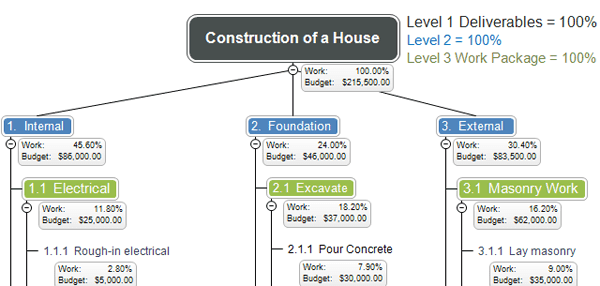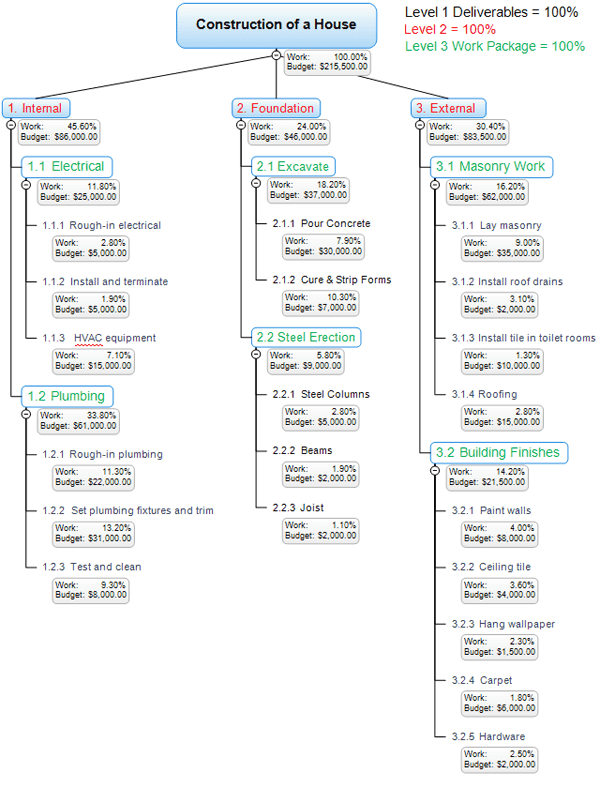A work breakdown structure (WBS) is a key project deliverable that organizes the team's work into manageable sections. The Project Management Body of Knowledge (PMBOK) defines the work breakdown structure as a "deliverable-oriented hierarchical decomposition of the work to be executed by the project team." The work breakdown structure visually defines the scope into manageable chunks that a project team can understand, as each level of the work breakdown structure provides further definition and detail. Figure 1(below) depicts a sample work breakdown structure with three levels defined.

An easy way to think about a work breakdown structure is as an outline or map of the specific project. A work breakdown structure starts with the project as the top level deliverable and is further decomposed into sub-deliverables using the following outline hierarchy (Figure 2):
The project team creates the project work breakdown structure by identifying the major functional deliverables and subdividing those deliverables into smaller systems and sub-deliverables. These sub-deliverables are further decomposed until a single person can be assigned. At this level, the specific work packages required to produce the sub- deliverable are identified and grouped together. The work package represents the list of tasks or "to-dos" to produce the specific unit of work. If you've seen detailed project schedules, then you'll recognize the tasks under the work package as the "stuff" people need to complete by a specific time and within a specific level of effort.
From a cost perspective, these work packages are usually grouped and assigned to a specific department to produce the work. These departments, or cost accounts, are defined in an organizational breakdown structure and are allocated a budget to produce the specific deliverables. By integrating the cost accounts from the organizational breakdown structure and the project's work breakdown structure, the entire organization can track financial progress in addition to project performance.
Why use a Work Breakdown Structure?
The work breakdown structure has a number of benefits in addition to defining and organizing the project work. A project budget can be allocated to the top levels of the work breakdown structure, and department budgets can be quickly calculated based on each project's work breakdown structure. By allocating time and cost estimates to specific sections of the work breakdown structure, a project schedule and budget can be quickly developed. As the project executes, specific sections of the work breakdown structure can be tracked to identify project cost performance and identify issues and problem areas in the project organization. For more information about Time allocation, see the 100% Rule.
Project work breakdown structures can also be used to identify potential risks in a given project. If a work breakdown structure has a branch that is not well defined then it represents a scope definition risk. These risks should be tracked in a project log and reviewed as the project executes. By integrating the work breakdown structure with an organizational breakdown structure, the project manager can also identify communication points and formulate a communication plan across the project organization.
When a project is falling behind, referring the work breakdown structure will quickly identify the major deliverables impacted by a failing work package or late sub- deliverable. The work breakdown structure can also be color-coded to represent sub- deliverable status. Assigning colors of red for late, yellow for at risk, green for on-target, and blue for completed deliverables is an effective way to produce a heat-map of project progress and draw management's attention to key areas of the work breakdown structure.
Work Breakdown Structure Guidelines
The following guidelines should be considered when creating a work breakdown structure:
- The top level represents the final deliverable or project Sub-deliverables contain work packages that are assigned to an organization’s department or unit
- All elements of the work breakdown structure don’t need to be defined to the same level
- The work package defines the work, duration, and costs for the tasks required to produce the sub-deliverable
- Work packages should not exceed 10 days of duration
- Work packages should be independent of other work packages in the work breakdown structure
- Work packages are unique and should not be duplicated across the work breakdown structure
Tools to Create a Work Breakdown Structure
Creating a Work Breakdown Structure is a team effort and is the culmination of multiple inputs and perspectives for the given project. One effective technique is to organize a brainstorming session with the various departments that will be involved with the project. Project teams can use low-technology tools like a white board, note cards, or sticky note pads to identify major deliverables, sub-deliverables, and specific work packages. These cards can be taped to a wall and reorganized as the team discusses the major deliverables and work packages involved in the project.
The low-technology approach is easy to do; however, it does not work well with distributed teams or translate easily into an electronic format. There are several tools available that support mind mapping, brainstorming, and work breakdown structures. MatchWare MindView is an easy-to-use mind mapping software package that supports work breakdown structures, project outlines, Gantt charts, and exports easily into Microsoft Project for further schedule definition. Figure 3 provides an example of a work breakdown structure using Matchware MindView.

The key benefit to MatchWare MindView is its ease-of-use translating work breakdown structures into high level project schedules. A natural extension of the work breakdown structure is the project schedule. By brainstorming the project scope in a mind mapping tool, the project manager can easily assign budget and duration estimates. These budget and duration estimates can easily be exported into Microsoft Excel or Microsoft Project for additional planning and analysis. Project managers want tools that help accelerate their work and reduce the administrative burden that accompanies project management processes.
Work Breakdown Structure Video
Learn how to use MindView to easily create your Work Breakdown Structure / WBS. Apply numbering scheme, completion percentage (100% rule), resources, cost calculation, and more. This video also demonstrates different views as Timelines, Gantt chart, and mind map, as well as several export functions including MS Excel, MS Word, MS Project, etc.
References: workbreakdownstructure









0 Comment: